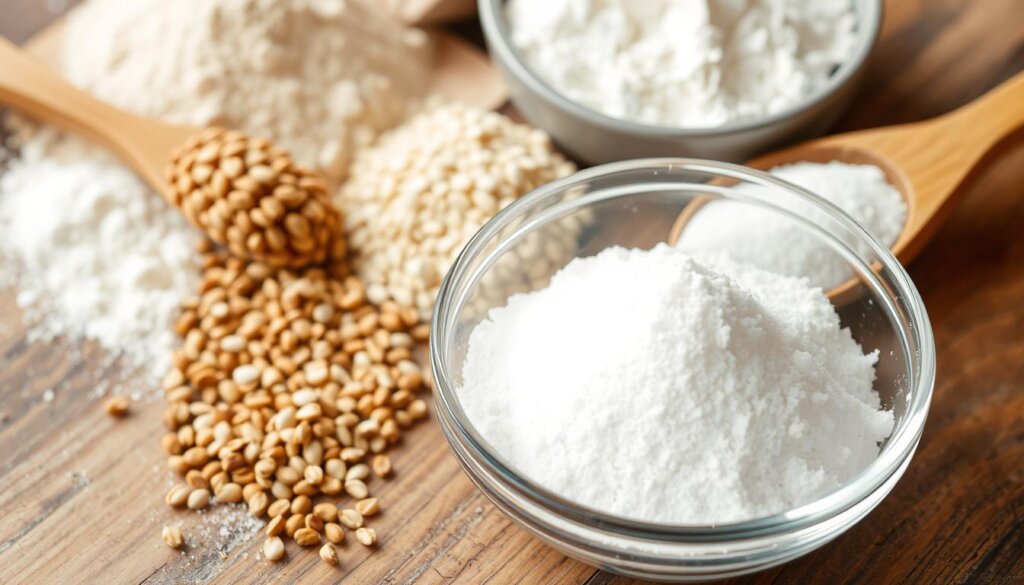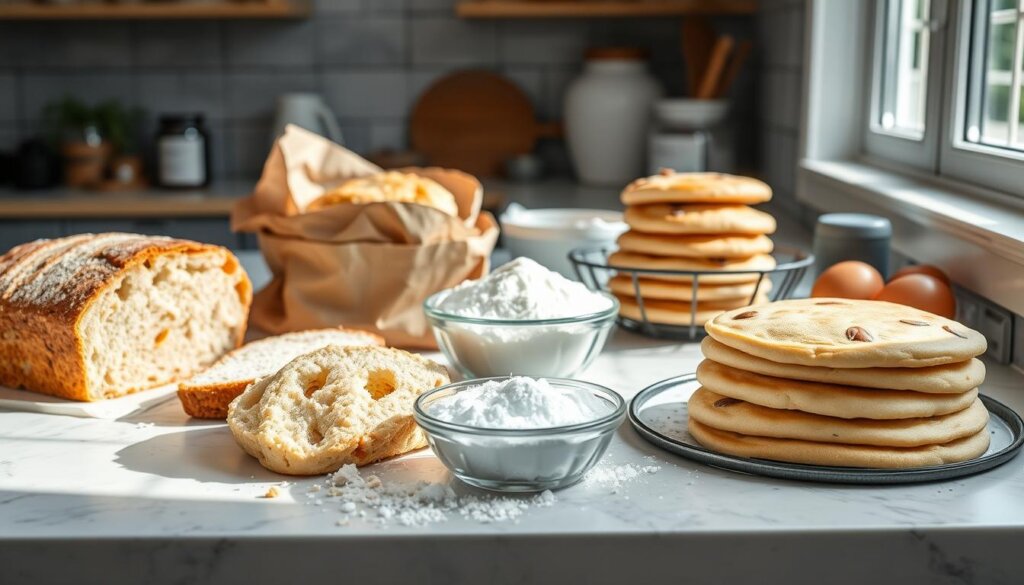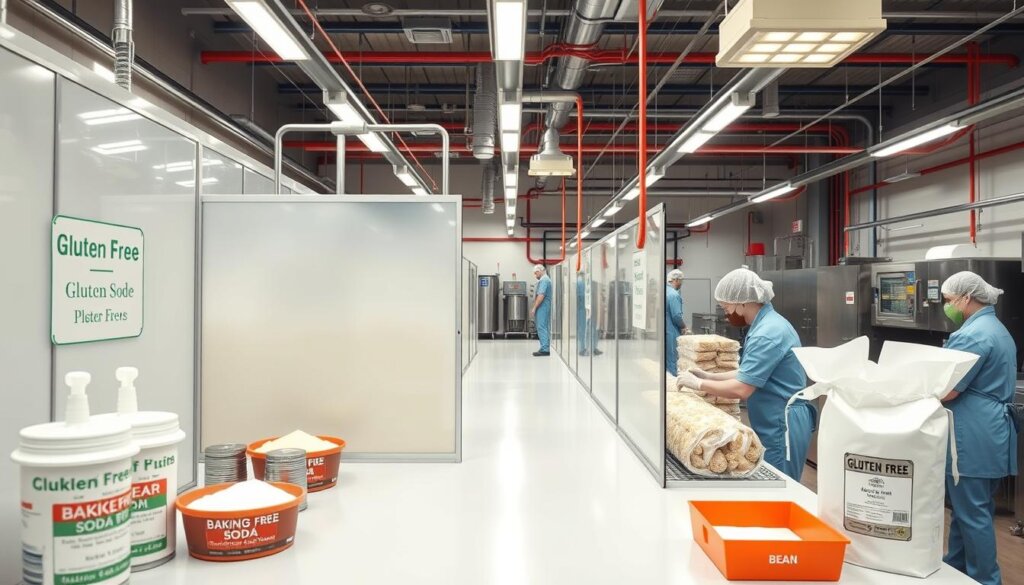Baking soda is a must-have in many kitchens, but is it truly safe for gluten-free baking? For those managing gluten sensitivities or celiac disease, understanding every ingredient is essential.
Baking soda itself is naturally gluten-free, but cross-contamination can occur in processing.
To make the most of your gluten-free bakes, explore tips for using gluten-free substitutes like Xanthan Gum in The Gluten-Free Truth About Xanthan Gum, discover versatile alternatives in Almond Flour as Breadcrumbs, or get inspired by recipes like Delicious Gluten-Free Bagels. Each offers valuable insights to keep your baking safe and delicious.
Table of contents
Understanding Baking Soda and Its Purpose
Baking soda is a key ingredient in many kitchens. It plays several vital roles in baking. Knowing what baking soda is helps us see its importance as a leavening agent.
Its main part, sodium bicarbonate, mixes with acidic ingredients. This mix creates carbon dioxide gas. This gas is key for making baked goods fluffy.
What is Baking Soda?
Baking soda is known as sodium bicarbonate. It’s a naturally occurring mineral. It has been used for
Is Baking Soda Gluten Free?
It’s important to know if baking soda is gluten-free for those with dietary restrictions. Baking soda, made mostly of sodium bicarbonate, does not have gluten. But, it’s key to pick brands that promise their baking soda is free from gluten contamination.
Baking Soda Ingredients Explained
The main part of baking soda is sodium bicarbonate, which is gluten-free. Brands like Arm & Hammer, Bob’s Red Mill, and Ener-G offer gluten-free baking soda. Always look for gluten-free seals on products. The gluten-free certification organization ensures they are safe from gluten.
Understanding Gluten and Its Sources
Gluten is a protein in some grains like wheat, barley, and rye. People with celiac disease or gluten sensitivities need to know where gluten is. Baking soda itself is safe, but always check labels to avoid gluten. Knowing this helps you bake safely and avoid health problems.

The Differences Between Baking Soda and Baking Powder
Baking powder and baking soda are not the same in the kitchen. Knowing the difference is key for gluten-free baking. They have different ingredients and uses.
What is Baking Powder?
Baking powder is a mix of an acid and a starch. It makes a chemical reaction that creates carbon dioxide gas. This makes your baked goods rise.
The common mix is baking soda, cream of tartar, and cornstarch. This mix is often used for gluten-free baking powder. Baking powder is 100% gluten-free, making it safe for those with gluten sensitivities.
The Role of Baking Powders in Gluten-Free Baking
Choosing the right leavening agent is key for gluten-free recipes. Double-acting baking powder is popular. It reacts twice, once with wet ingredients and again when heated.
This double reaction helps make gluten-free items light and fluffy. Brands like Argo, Bob’s Red Mill, and Clabber Girl offer gluten-free options. Knowing these options helps keep your diet safe.
People with celiac disease or gluten sensitivity must check packaging for allergens. Gluten-free baking soda sales have gone up 15% in a year. This shows the need to know about gluten in baking soda.
Research shows 60% of gluten-sensitive people react to gluten in baking soda. Baking powder is now a safer choice for gluten-free baking.
How to Use Baking Soda in Your Gluten-Free Diet
Exploring gluten-free baking is fun and tasty. It’s great to find recipes that use baking soda. Knowing how to swap out ingredients is key for great results.
Finding Suitable Recipes
Look for gluten-free recipes that mention baking soda. It’s important for the right texture and rise. You can use flours like almond or coconut to make dishes special. For more tips, check out this resource.
Substitutions in Baking
When using gluten-free flours, making baking substitutions is important. These flours need adjustments to rise like regular flours. You might need more liquid, like applesauce or yogurt. Also, make sure to measure baking soda right for the best results.

Potential Cross-Contamination Issues
Cross-contamination is a big worry for people with gluten sensitivities or celiac disease. Baking soda is often made in the same place as gluten products. This means there’s a higher chance of gluten getting into your food. Knowing how to pick safe products is key.
Understanding Manufacturing Practices
Many places make baking soda and gluten products together. This can lead to gluten getting into your food. It’s important to choose brands that are careful about keeping things gluten-free. Look for products that say they are gluten-free to avoid gluten.
How to Choose Safe Products
Choosing the right baking products is important. Here are some tips:
- Check for gluten-free certifications on packaging.
- Review ingredient labels for information regarding allergens.
- Opt for brands renowned for dedicated gluten-free manufacturing processes.
- Consult consumer reviews or resources that verify manufacturing practices.
Using these tips can help you avoid cross-contamination in your baking.
| Brand | Gluten-Free Certification | Manufacturing Practices |
|---|---|---|
| Bob’s Red Mill | Yes | Dedicated gluten-free facility |
| King Arthur Baking Company | Yes | Strict quality control measures |
| Arm & Hammer | No | Shared facilities, possible cross-contamination |

Homemade Baking Soda Alternatives
Making your own baking powder is a great choice for those worried about cross-contamination. It lets you pick your ingredients, making sure they fit your diet. Here’s a simple recipe for homemade baking powder to try.
Creating Your Baking Powder at Home
To make your own baking powder, mix these ingredients:
- 1 part baking soda (a versatile DIY baking soda)
- 2 parts cream of tartar
- 1 part cornstarch (to prevent clumping)
These ingredients make a good homemade baking powder. Keep it in an airtight container to keep it fresh. Always check it before using to ensure it’s good quality.
Ingredient List for Safe Homemade Baking Powder
| Ingredient | Measurement |
|---|---|
| Baking Soda | 1 tablespoon |
| Cream of Tartar | 2 tablespoons |
| Cornstarch | 1 tablespoon |
This mix is a good homemade baking powder. It’s safe and flexible. You can adjust the amounts to get the perfect mix for you.
Conclusion
Ensuring baking ingredients, like baking soda, are gluten-free is very important. About 1% of people worldwide have celiac disease. For those on a gluten-free diet, following safe baking practices is key.
Wheat is a big source of gluten, and even a little can harm some people. When baking, always check labels carefully. Choose brands known for their quality and avoiding gluten.
Even though baking soda is usually safe, be careful. It can get contaminated with gluten if not stored right. Always keep your baking area clean and safe.
For extra safety, try making your own gluten-free baking powder. It’s a way to control what goes into your food and can save money. This way, you can bake safely and enjoy your gluten-free treats.
FAQ
Is baking soda gluten-free?
Yes, baking soda is gluten-free. It’s made of sodium bicarbonate, which doesn’t have gluten. But, make sure the baking soda you buy isn’t mixed with gluten during making.
What is the role of baking soda in gluten-free baking?
Baking soda helps make baked goods light and fluffy. It does this by reacting with acids in recipes. This is key in gluten-free baking because it replaces the role of gluten.
How can I check if my baking soda is safe?
To make sure your baking soda is gluten-free, look for labels that say so. Also, check the ingredient list for allergen warnings. This is important for baking powders and other helpers too.
Can I use baking powder instead of baking soda in gluten-free recipes?
You can use baking powder, but be careful. It has an acid and starch, which might not be gluten-free. Always pick gluten-free baking powders and adjust the recipe as needed.
What types of flours are recommended when baking gluten-free?
Try almond flour, coconut flour, or oat flour instead of wheat flour. Each one might need different amounts of liquid and helpers to get the right texture.
What steps can I take to avoid cross-contamination in baking?
To avoid cross-contamination, pick brands that say they’re gluten-free. Use special gluten-free tools and always check labels for allergens.
How can I make my own gluten-free baking powder?
Mix baking soda, cream of tartar, and cornstarch in a 1:2:1 ratio. This makes a safe, gluten-free baking powder at home.
What should I do if I experience symptoms of gluten intolerance after baking?
If you think you have gluten intolerance, see a doctor. Keep a food diary and talk to your doctor about your baking ingredients. This can help find where the gluten is coming from.





